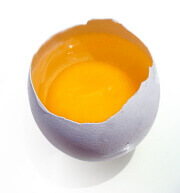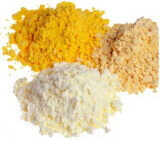 Egg powder and liquid egg, mainly from yolk, are used in many food products, among other low fat mayonnaises. All egg is pasteurised but as egg naturally contain α-amylase, some residuals may remain after pasteurisation. Pasteurisation temperature and time are critical for the result. A variation of only one degree centigrade will determine success of enzyme degradation.
Egg powder and liquid egg, mainly from yolk, are used in many food products, among other low fat mayonnaises. All egg is pasteurised but as egg naturally contain α-amylase, some residuals may remain after pasteurisation. Pasteurisation temperature and time are critical for the result. A variation of only one degree centigrade will determine success of enzyme degradation.
If α-amylase containing egg products are mixed with starch there is a risk of degradation of starch and consequently loss of texture. As starch is often used as a thickener in products like mayonnaise, soups and blends, these products are more sensitive to residual α-amylase. Only a very low α-amylase activity will have significant effect on the texture of the final product. It is also important for bakeries etc to control their ingredients to avoid degradation of starch and loss of bread texture. During recent years, there has been significant growth in the use of egg products, i.e. eggs which have been taken out of their shell. The increase in use of egg products and egg powder is due to the sustainability and the improved shipping possibilities.
 Phadebas Amylase Test has been used for the determination of α-amylase activity in egg powders for many years. Laboratories use Phadebas to ensure that the pasteurisation process is sufficient. Already in 1986, Jäckle and Geiges* described a method using Phadebas Amylase Test to determine α-amylase activity in eggs. Several labs have developed their own methods for egg analysis based on Phadebas. Though we never released a method dedicated for analysing eggs, we constantly strive to understand our customers’ needs. Thus, we have in-house methods and ideas around how to work with opaque solutions and very low activities. If you have any questions, please contact us at info@phadebas.com or support@phadebas.com and we will do our best to help you.
Phadebas Amylase Test has been used for the determination of α-amylase activity in egg powders for many years. Laboratories use Phadebas to ensure that the pasteurisation process is sufficient. Already in 1986, Jäckle and Geiges* described a method using Phadebas Amylase Test to determine α-amylase activity in eggs. Several labs have developed their own methods for egg analysis based on Phadebas. Though we never released a method dedicated for analysing eggs, we constantly strive to understand our customers’ needs. Thus, we have in-house methods and ideas around how to work with opaque solutions and very low activities. If you have any questions, please contact us at info@phadebas.com or support@phadebas.com and we will do our best to help you.
* Bestimmung der Alpha-Amylase-Aktivität in Vollei und Eigelb mit dem Phadebas® Amylase Test, M. Jäckle under O.Geiges, Mitt. Gebiete Lebensm. Hyg. 77, 420-434, 1986
